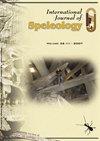Airflow dynamics in Wind Cave and Jewel Cave: How do barometric caves breathe?
IF 1.3
4区 地球科学
Q3 GEOSCIENCES, MULTIDISCIPLINARY
引用次数: 2
Abstract
Recent research on air pressure propagation through barometric caves has revealed various speleoclimatological processes, which cause a more complex relationship between surface air pressure changes and resulting pressure gradients between cave and surface air than previously assumed. So far, however, studies on barometric cave airflow have only been based on surface air pressure measurements. Thus, this study investigates and compares airflow at the openings of Wind Cave and Jewel Cave – two major barometric cave systems in South Dakota, USA – as a response to surface air pressure changes and air pressure gradients. Based on high-resolution long-term air pressure measurements from the surfaces and several locations inside the caves, as well as ultra-sonic airflow measurements at the openings, the analysis proves that for both caves, cave airflow velocity can be predicted more accurately by air pressure gradients than by previous surface air pressure changes. An inter-cave comparison also reveals substantial differences in cave airflow dynamics between Wind Cave and Jewel Cave, with the relevant period of surface air pressure variations for cave airflow velocity and the cave reaction times being significantly longer at Jewel Cave compared to Wind Cave. Therefore, the findings of this study demonstrate the effects of cave morphology on airflow and significantly contribute to a better understanding of the speleoclimatological mechanisms and dynamics of compensating airflow at the openings of barometric caves.风洞和珠宝洞的气流动力学:气压洞穴是如何呼吸的?
最近对气压洞穴中气压传播的研究揭示了各种洞穴气候过程,这些过程导致地表气压变化与洞穴和地表空气之间产生的压力梯度之间的关系比以前假设的更为复杂。然而,到目前为止,对气压洞穴气流的研究仅基于地面气压测量。因此,本研究调查并比较了美国南达科他州两个主要的气压洞穴系统——风洞和宝石洞洞口的气流对地表气压变化和气压梯度的响应。基于对洞穴表面和洞穴内多个位置的高分辨率长期气压测量,以及在洞口的超声波气流测量,分析证明,对于两个洞穴,通过气压梯度比以前的表面气压变化更准确地预测洞穴气流速度。洞间对比也揭示了风洞与宝石洞在洞穴气流动力学上的显著差异,宝石洞的地表气压变化与洞穴气流速度的相关周期和洞穴反应时间明显长于风洞。因此,本研究结果揭示了洞穴形态对气流的影响,有助于更好地理解洞穴气候学机制和洞穴洞口补偿气流的动力学。
本文章由计算机程序翻译,如有差异,请以英文原文为准。
求助全文
约1分钟内获得全文
求助全文
来源期刊

International Journal of Speleology
地学-地球科学综合
CiteScore
3.10
自引率
23.10%
发文量
12
审稿时长
>12 weeks
期刊介绍:
The International Journal of Speleology has the aim to get cave and karst science known to an increasing number of scientists and scholars. The journal therefore offers the opportunity to all scientists working in and on karst to publish their original research articles or their review papers in an open access, high quality peer reviewed scientific journal at no cost. The journal offers the authors online first, open access, a free PDF of their article, and a wide range of abstracting and indexing services.
 求助内容:
求助内容: 应助结果提醒方式:
应助结果提醒方式:


